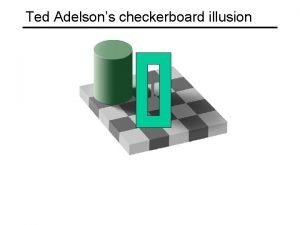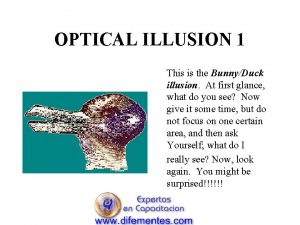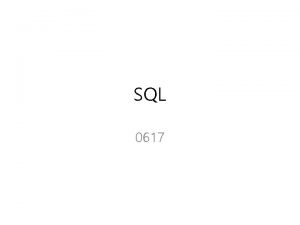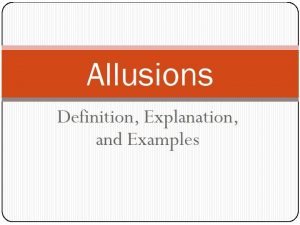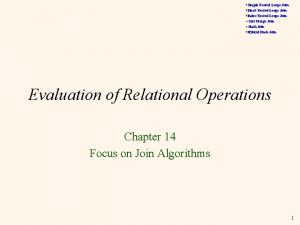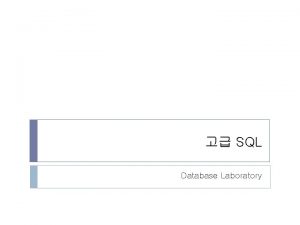To Join or Not to Join The Illusion



















- Slides: 19

To Join or Not to Join: The Illusion of Privacy in Social Networks with Mixed Public and Private User Profiles By Elena Zheleva, Lise Getoor Presented by Ionut Trestian

Privacy is important ! (1)

Privacy is important ! (2)

Privacy is important ! (3) • Sometimes it’s not the user who accidently exposes private information • Groups, organizations that the users belong to might expose information accidentally or not

Contributions • Identify novel social network attacks • We show that such attacks can be carried out even with limited information • We evaluate our attacks on real social network data (Flickr, Facebook, Dogster and Bib. Sonomy) • Discuss how our study affects anonymization of social networks

Types of attacks • Attacks without links and groups {BASIC} – Pick the most probable attribute from public profiles – Simple, use as a baseline • Privacy attacks using links • Privacy attacks using groups • Privacy attacks using links and groups

Privacy attacks using links • Friend-aggregate model (AGG) – Pick the most probable attribute value from friends • Collective classification model (CC) – Iterative classification • Flat-link model (LINK) – Traditional classifiers, Bayes etc • Blockmodeling attack (BLOCK) – Obtain blocks (clusters of users) and find where the user belongs

Privacy attacks using groups • Groupmate-link model (CLIQUE) – Assume group members are friends • Group-based classification model (GROUP) – Consider groups as features – Not all groups are relevant

Privacy attacks using links and groups • Combine flat-link and group-based classification models into one • LINK-GROUP • Can use any traditional classifier

Experiments - Data • Flickr - 9, 179 users from 55 countries (47, 754 groups) • Facebook – 1, 598 users – political views • Dogster – 2, 632 dogs – 1, 042 groups • Bib. Sonomy – 31, 175 users + tags

Results (1) • 50% private profiles

Results GROUP (2)

Results GROUP (3)

Results GROUP (4)

Results GROUP (5)

Results GROUP (6)

Results GROUP (7)

Discussion • Joining heterogeneous groups preserves privacy better • Display Group information only to friends • Remove homogeneous groups

Thank you ! Questions ?
 Sadlier vocabulary workshop level d unit 1
Sadlier vocabulary workshop level d unit 1 ưu thế lai là gì
ưu thế lai là gì Thẻ vin
Thẻ vin Môn thể thao bắt đầu bằng chữ f
Môn thể thao bắt đầu bằng chữ f Tư thế ngồi viết
Tư thế ngồi viết Cái miệng xinh xinh thế chỉ nói điều hay thôi
Cái miệng xinh xinh thế chỉ nói điều hay thôi Hát kết hợp bộ gõ cơ thể
Hát kết hợp bộ gõ cơ thể Từ ngữ thể hiện lòng nhân hậu
Từ ngữ thể hiện lòng nhân hậu Trời xanh đây là của chúng ta thể thơ
Trời xanh đây là của chúng ta thể thơ Tư thế ngồi viết
Tư thế ngồi viết V cc cc
V cc cc Voi kéo gỗ như thế nào
Voi kéo gỗ như thế nào Thể thơ truyền thống
Thể thơ truyền thống Hươu thường đẻ mỗi lứa mấy con
Hươu thường đẻ mỗi lứa mấy con Diễn thế sinh thái là
Diễn thế sinh thái là đại từ thay thế
đại từ thay thế Thế nào là hệ số cao nhất
Thế nào là hệ số cao nhất Vẽ hình chiếu vuông góc của vật thể sau
Vẽ hình chiếu vuông góc của vật thể sau Thế nào là mạng điện lắp đặt kiểu nổi
Thế nào là mạng điện lắp đặt kiểu nổi




















